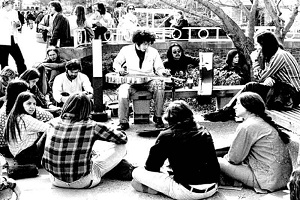No, it’s not a rhetorical question from a 1960s folk song, though the answer is based in that era. It’s a question we often get asked when we make presentations to local communities around Australia. It seems many local areas had decreasing populations of 25-34 year olds in the 2001-2006 Census period. Because people aged 25-34 are a key demographic with a high participation in the workforce, this sometimes causes some angst. The usual reason suggested for the decline is a “lack of affordable housing”, and it is true that in that age range many people are looking for housing, particularly to buy their first home. While there may be different reasons in different areas, the main source of this change is actually a bit simpler.

Here is a good example of an area with a large loss of 25-34 year olds.

The City of Whitehorse in Melbourne’s eastern suburbs gained population in every other age group between 2001 and 2006, but had a very large reduction in 25-34 year olds (-2,386 people, or 11% of total). It’s not alone. We find the same trend in many of the middle and outer suburbs of our capital cities, and regional centres. See, for example, Hawkesbury (NSW), Monash (Vic), Mitcham (SA, ), Fremantle (WA), Redland (Qld) and Glenorchy (Tas).
Some reasons for this loss can be:
- Young people moving overseas and not returning.
- Unaffordable housing pushing people out of established suburbs.
- 25-34 year olds less likely to fill in the Census.
These are all possible factors. Young people DO travel overseas, and they generally DO need more affordable housing. Most people are renting early in that age bracket but usually buying a home by the later part. And if your housing prices and rents are on the increase this may push them out. However, a word of caution before reading too much into the decline of this age group in your local area. I looked into this, using .id’s new Australia-wide community profile. You can check it out yourself here.
And Australia-wide, 25-34 year olds declined by nearly 47,000 people between 2001 and 2006. No wonder that the majority of LGAs show a decline! Along with 5-11 year olds it was the only age group to show a decline for the whole country. Some of this may be due to them moving overseas (and with the high dollar I think we’ll see more of this in 2011), but the simpler explanation is that they were born at a time of decreasing birth rates.
Australia’s birth rate was high through the 1950s and early 1960s (the post-war baby boom), declining sharply in 1961 with the introduction of the contraceptive pill, and then declining even more sharply in the early 1970s. See the chart below, courtesy of the ABS (Births, Australia, 3301.0), with annotations by .id.

In the space of just 9 years, from 1971 to 1980, Australia’s fertility rate declined from 2.95 to 1.90, and stayed there, declining slightly further over the next 20 years, before rising a little in the most recent baby boom (see my previous post about high birth rate in Australia). The number of babies born in 1979 was 53,000 less than the number born in 1971.
Now 25-34 year olds in 2006 were born between 1971 and 1980 corresponding exactly with this large drop in fertility. In 2001, 25-34 year olds were those born between 1966 and 1976, which covered some of the drop but still had relatively high rates compared to the later period.
So the explanation is simple – there just aren’t as many people in that age cohort, and you can see it moving through – from 1996-2001, the main drop was among those aged 20-29. In fact the drop would have been much larger if it weren’t for the fact that we have been increasing our population through migration, and the largest share of the migrants are aged in their 20s and 30s. So while we are likely to see a small drop in 30-39 year olds in the 2011 Census due to the ageing of the smaller cohort, the very high migration we’ve had since 2006 (read more about Australia’s migration here), will mitigate this effect – in fact it’s possible that we may not see a drop at all. On the other hand, more people may have left for overseas…
And of course not all areas had declines in the number of 25-34 year olds even between 2001 and 2006. Though most areas did decline in percentage terms, places which attract young adults such as the inner cities – Port Phillip (Vic) and Sydney (NSW) did increase their number and share of 25-34 year olds.
So it’s worth keeping these broader trends in mind when looking at the data for local areas. The reason behind a change is not always a local one. Although there are certainly local effects which differ from suburb to suburb (which is why we emphasise the need for local area information), broad national trends also have an effect on most areas.
If you need any assistance with understanding the data in profile.id, feel free to contact the population experts at .id (03) 9417-2205 or info@id.com.au. And do follow us on Twitter @dotid or check out our website at id.com.au for more information about population change in Australia.












